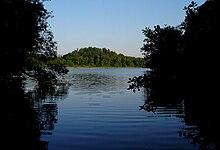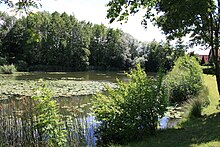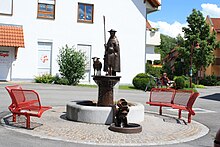Schlier (municipality)
| coat of arms | Germany map | |
|---|---|---|

|
Coordinates: 47 ° 46 ' N , 9 ° 40' E |
|
| Basic data | ||
| State : | Baden-Württemberg | |
| Administrative region : | Tübingen | |
| County : | Ravensburg | |
| Local government association: | Gullen | |
| Height : | 596 m above sea level NHN | |
| Area : | 32.58 km 2 | |
| Residents: | 3882 (December 31, 2018) | |
| Population density : | 119 inhabitants per km 2 | |
| Postal code : | 88281 | |
| Area code : | 07529 | |
| License plate : | RV, SLG , ÜB , WG | |
| Community key : | 08 4 36 069 | |
| Address of the municipal administration: |
Rathausstrasse 10 88281 Schlier |
|
| Website : | ||
| Mayoress : | Katja Liebmann | |
| Location of the municipality of Schlier in the Ravensburg district | ||

Schlier is a municipality in the district of Ravensburg in Baden-Württemberg in Germany .
The municipality of Schlier, which is predominantly agricultural and covers an area of 32.58 km², has more than 3800 inhabitants.
geography
location
The municipality of Schlier is located on the southern edge of the Altdorf Forest above or east of the Schussental a few kilometers east of the cities of Ravensburg and Weingarten .
Neighboring communities
The municipality of Schlier borders on the municipalities of Baienfurt , Bergatreute , Grünkraut , Waldburg , Vogt , Wolfegg and the cities of Ravensburg and Weingarten .
Community structure
The municipality of Schlier consists of the main suburbs Schlier and Unterankenreute as well as over 30 hamlets and individual farms, including the largest hamlets of Erbisreute , Fenken, Hintermoos and Wetzisreute.
The other hamlets and farms are Albisreute, Appenberg, Dietenbach, Eratsrain, Fechtberg, Furtbach, Fuchsenloch, Gessenried, Grieble, Katzheim, Kehrenberg, Kocherhof, Krautenau, Lanzenreute, Lauratal , Maierhanser, Mühlenreute, Oberankenreute, Richlisreute, Rößlerhof, Schirnbuch, Rößlerhof Starental, Steinrausen, Stöcklisberg, Unterankenreute and Zundelbach.
history
In the year 861, a document from St. Gallen reported for the first time about the hamlet of Kehrenberg, which belongs to this monastery, in today's municipality of Schlier. From 1056 a rich documentary tradition can be read in the code of tradition , the Rödeln and land registers of the Weingarten monastery . Around 1100 Duke of the Welf, Heinrich the Proud, gave two estates in Gessenried to Weingarten Monastery . Towards the middle of the 13th century, a considerable part of today's Schlier community belonged to Weingarten Monastery through donations and acquisitions. The first mention by name is in a contract from 1269 between the Weingarten monastery and the Truchsessen von Waldburg, where a knight Rufus de Sliere appears as a witness. At that time, the area belonged to several gentlemen, in particular to Weingarten Monastery, the Truchsessen von Waldburg and the Lords of Wildenegg, some farms to the Lords of Ankenreute and Richlisreute, a single farm to the Einsiedeln monastery and Kehrenberg to the St. Gallen monastery . From the end of the 13th century, most of these feudal estates came to the Weingarten Monastery as a gift or purchase.
In 1525 rebellious farmers camped in Schlier, which went down in history as Seehaufen , Allgäuer Haufen and Baltringer Haufen and also forced the feudal people of Weingarten Monastery to participate. Georg Truchsess von Waldburg-Zeil , better known as Bauernjörg , signed the Weingarten contract with them and thus avoided open battle. The almost surrender of the peasants nevertheless gave him the opportunity to live in the lowlands, e.g. B. in Böblingen to suppress the peasant revolts there all the more cruelly. The Galgenberg in Waldburg was the end of the line for the captured farmers. During the Thirty Years War , the area around Schlier was not only plundered by the Swedes, but also hit by several plague epidemics and famine. In a list of the Weingarten monastery from 1637, 130 surviving residents are named, in 1648 only 14 farms were left. Around 80 percent of the previous population no longer existed. In order to repopulate the farms, farmers are recruited from Switzerland, Tyrol and Vorarlberg, whose family names still tell of their origin. They seem to have been fruitful, because as early as 1690 many Schlier citizens emigrated as Danube Swabians mainly to Hungary and the Banat, later Yugoslavia. Among them is a Johann Broz, possibly an ancestor of Josip Broz Tito .
Looting by French and Russian troops was announced between 1791 and 1800, the Russian cemetery in the forest on the side of the road from Weingarten to Unterankenreute still tells us today that many Cossack and Tatar soldiers died in the Weingarten hospital. In the Reichsdeputationshauptschluss , Weingarten Abbey was awarded to the Prince of Nassau-Dillenburg as compensation for possessions on the left bank of the Rhine in Holland and Belgium. In 1806 the area was added to the (Protestant) Kingdom of Württemberg by Emperor Napoleon , which met with very little approval in the predominantly Catholic Upper Swabia. On June 12, 1812 Schlier became a royal Wuerttemberg community by royal rescript .
There were 61 dead after the First World War, 90 in the Second World War.
Religions
Like the entire surrounding area, Schlier is shaped by the Roman Catholic denomination. Until 1822 the inhabitants belonged to the parish Weingarten. The Roman Catholic parish of St. Martin in Schlier belongs to the Allgäu-Oberschwaben deanery of the Rottenburg-Stuttgart diocese and also includes the Unterankenreute branch parish. In addition to the two churches of St. Martin in Schlier and Mariä Himmelfahrt in Unterankenreute, there are chapels in Hintermoos (St. Sebastian), Unterankenreute (St. Sebastian) and Wetzisreute (St. Joseph and Georg, so-called Boserkapelle).
The Protestant Christians of the community belong to the parish Weingarten (Pfarramt Weingarten II) in the church district Ravensburg of the Evangelical Church in Württemberg .
politics
Administrative association
Schlier is part of the Gullen municipal administration association based in Grünkraut .
Municipal council
The municipal council consists of the elected voluntary councilors and the mayor as chairman. The mayor is entitled to vote in the municipal council. After the local elections on May 26, 2019 (turnout 67.3%), the following distribution of seats resulted.
- Free voter association: 37.4% (+ 5.2%) - 6 seats (+1)
- village - living - shaping (dlg): 30.3% (+2.6%) - 4 seats (± 0)
- Independent voters' association Schlier (UWV): 22.4% (−0.6%) - 3 seats (± 0)
- CDU : 9.8% (−7.3%) - 1 seats (−1)
mayor
Until 1933 the community leaders were called Schultheißen and since then mayors .
- 1812–1818 Anton Schattmaier von Schattbuch
- 1818–1824 Martin Rist von Albisreute
- 1824–1825 Prince, farmer on the Rößlerhof
- 1826–1834 Nikolaus Schuler as community carer
- 1834–1836 Anton Rist, farmer in Mühlenreute
- 1836–1843 Baptist Pfeiffer von Schlier
- 1843–1848 Anton Sterk von Richlisreute
- 1848–1860 Jakob Fricker von Schlier
- 1860–1889 Josef Fricker von Unterankenreute
- 1889–1909 Franz Joseph Heiß von Zundelbach
- 1909–1934 Benedikt Hafner
- 1934–1935 Karl Loritz from Waldburg
- 1935–1938 Xaver Fiegle from Vogt
- 1938–1945 Stefan Müller from Laupheim
- 1945–1946 Hugo Hagel, acting
- 1946–1966 Heinrich Hafner, Schlier
- 1966–1994 Arnold Maier
- 1994–2016 Reimund Hausmann
- since the end of 2016 Katja Liebmann, she was elected in October 2016
coat of arms
The coat of arms was created in 1954, approved by the state government in 1955 and revised in 1987. The blazon reads: In silver a red lion, in the right upper corner in red a silver hand of oath .
The hand of the oath is intended to remember the Lords of Ankenreute, who once played an important role. The armored knight's fist reproduced in its coat of arms at the time was considered too martial in 1954 and therefore no longer in keeping with the times. The Guelph lion and the Guelph colors red and silver are a reminder of the centuries-long affiliation of the place to Weingarten Monastery, which was once founded by the Guelphs.
Economy and Infrastructure
traffic
The community is with some bus lines u. a. connected with Ravensburg , Vogt and Wangen im Allgäu and belongs to the Bodensee-Oberschwaben Verkehrsverbund ( bodo ).
education
In the two districts of Schlier and Unterankenreute there is a Roman Catholic kindergarten and a primary school.
Personalities
- Gottlieb Marktanner-Turneretscher (1858–1920), natural scientist, museum clerk and photographer, born in Unterankenreute, active in Graz
literature
- Columban Buhl: The community Schlier. Between the Schussental and Altdorf Forest . Eppe, Bergatreute 1985, ISBN 3-89089-051-2
- Johann Daniel Georg von Memminger: community Schlier . In: Description of the Oberamt Ravensburg. Cotta, Stuttgart and Tübingen 1836 ( full text at Wikisource )
- Schlier and its districts. People and moments. Pictures tell a story . Geiger, Horb am Neckar 2004, ISBN 3-89570-958-1
Web links
Individual evidence
- ↑ State Statistical Office Baden-Württemberg - Population by nationality and gender on December 31, 2018 (CSV file) ( help on this ).
- ^ Chronicle of the Ravensburg district . Chroniken-Verlag, Hinterzarten 1975, p. 787
- ↑ Election of the Schlier municipal council, May 26th, 2019. Retrieved June 3, 2019 .
- ↑ http://www.schwaebische.de/region_artikel,-Schliers-Buergermeisterin-startet-am-6-Dezember-_arid,10546323_toid,536.html
- ↑ Austrian Biographical Lexicon








